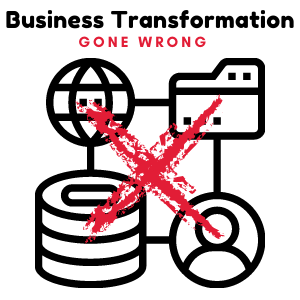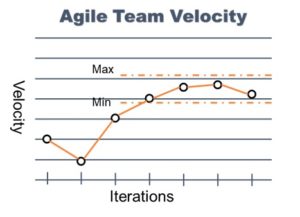In today’s business world, organizations continually seek ways to stay ahead of the competition through building efficiencies (to reduce costs and overheads), enticing existing customer base (to stabilize revenue), and/or growing customer base (to increase revenue). However, not every organization takes on a ‘transformative’ initiative to achieve these goals. Some organizations find themselves on a steady innovative path to achieve these goals through incremental and continuous improvements; they can do so due to a future-proof/sustainable strategy and prior long-horizon decisions. On the other hand, there are many organizations that are recognizing the need to evolve and make significant but fundamental shifts in their strategy to stay relevant and competitive. This article will focus on the latter and delve into some common points of failure for business transformation initiatives.
What is Business Transformation?
Business Transformation typically refers to a revolutionary change (instead of an evolutionary one) that fundamentally re-aligns or shifts an organization’s strategy. In short, this is a big change with a cascading impact across all (or most) critical dimensions of an organization, such as people, processes, tools, and technologies. A transformation may be focused on a variety of aspects, such as operations, delivery, overall business model among others – regardless of the focus, this transformation is likely to have wide-ranging consequences for the overall business and thus warrants visibility and sponsorship from the most senior leadership. Here are some business transformation initiatives that have crossed my path:
Operational Efficiency Focus
(in the face of fierce competition, industry-wide innovation, and rising customer expectations)
- Protect profit margin on legacy products (with a finite lifetime but the highest impact on company’s current revenue) – key dimensions included; keep customers happy, lower costs by driving out waste and inefficiencies, and keep employees engaged and productive
- Optimize the rollout of new innovative product offerings (with limited impact on company’s current revenue but the highest impact on future sustainability) – key dimensions included; entice customers with quality, speed of execution and experience, keep costs low through lean processes, and keep employees engaged and productive
Change in Business Model
(to shift from a not-for-profit model to a for-profit model)
- Strategic shift at the leadership level, including a new focus on P&L, economics, competition, and people stewardship (into the new model)
- Cultural adjustment, to help shift employee’s focus from ‘maintaining status quo’ to ‘enticing and winning customers with new and innovative products’
- Delivery adjustment, to improve speed to market, delivery predictability, and alignment to customer’s expectations
Modernization of Technology
(to ensure continued technology operations)
- Retire and replace end-of-life technology infrastructure to eliminate exponentially increasing cost of maintenance and risk of catastrophic failure
- Select and deploy new technology and appropriate mechanisms to continually evolve the infrastructure, with empahsis on the delivery of incremental business value and overall execution speed
Product Delivery Overhaul
(to respond to a catastrophic failure and lack of confidence in efficacy of current methods)
- Ensure strategic rollout of products from the time of conception to delivery and beyond, including alignment to customer expectations, time to market, predictable commitments, and structured execution against a defined product vision and roadmap
Common POINTS of Failure
Transformation as a Project/Program
 It is common for transformation initiatives to be considered finite in nature, with a predefined delivery date like a project or a program. While it is understandable for executives to have certain outcome expectations, it is unrealistic to think that a transformation could be completed in 6 months or a year. And even if you can achieve some tactical outcomes (such as operational savings or successful product deliveries) in a limited time, it is not a guarantee of the success of the overall transformation. The key reason behind this is the fundamental complexity of a transformation that transcends beyond a simple change in a system or a process; it typically impacts people, processes, tools, and/or technologies in a more significant manner, and requires a change in people’s behaviors and actions. While mandating the change in behaviors and action might produce some debatable short-term results, they are not likely to stick. We are essentially looking to change the organization’s culture and that takes a long time. The stronger the organization’s culture and history, the harder it is to change it – this warrants a need for a structured and well-planned change with involvement from the impacted employees.
It is common for transformation initiatives to be considered finite in nature, with a predefined delivery date like a project or a program. While it is understandable for executives to have certain outcome expectations, it is unrealistic to think that a transformation could be completed in 6 months or a year. And even if you can achieve some tactical outcomes (such as operational savings or successful product deliveries) in a limited time, it is not a guarantee of the success of the overall transformation. The key reason behind this is the fundamental complexity of a transformation that transcends beyond a simple change in a system or a process; it typically impacts people, processes, tools, and/or technologies in a more significant manner, and requires a change in people’s behaviors and actions. While mandating the change in behaviors and action might produce some debatable short-term results, they are not likely to stick. We are essentially looking to change the organization’s culture and that takes a long time. The stronger the organization’s culture and history, the harder it is to change it – this warrants a need for a structured and well-planned change with involvement from the impacted employees.
Lack of Stickiness
 A transformation is sometimes deemed successful after seeing desired results in the short-term; as previously mentioned, these results are typically driven through mandates. Unfortunately (or fortunately!), mandates do not tend to last in the long-term because either the leadership focus shifts with time, and/or these mandates disengage the employees to a point that they burn-out and decide to seek gainful employment elsewhere. Despite significant investment in these transformation initiatives, it is a common phenomenon for organizations to deal with the same problems again over time due to lack of stickiness. This usually leads to a vicious cycle of transformations that yield minimal results, thus creating a sense of perpetual skepticism among employees about the efficacy of any such effort. It is common to hear phrases like;
A transformation is sometimes deemed successful after seeing desired results in the short-term; as previously mentioned, these results are typically driven through mandates. Unfortunately (or fortunately!), mandates do not tend to last in the long-term because either the leadership focus shifts with time, and/or these mandates disengage the employees to a point that they burn-out and decide to seek gainful employment elsewhere. Despite significant investment in these transformation initiatives, it is a common phenomenon for organizations to deal with the same problems again over time due to lack of stickiness. This usually leads to a vicious cycle of transformations that yield minimal results, thus creating a sense of perpetual skepticism among employees about the efficacy of any such effort. It is common to hear phrases like;
- “We did this before and it didn’t work”
- “This is the flavor of the year”
- “We can just wait it out”
The above has a side-effect of negatively impacting the organizational culture, leading to employees mistrusting leadership, lacking commitment, and feeling disengaged. This is the opposite of what we want to accomplish, and therefore it is critical to invest and plan for sustainability rather than short-term gains. This focus on sustainability will have you asking insightful questions about how you can win over your employees and have them collectively drive and re-enforce the intended changes over the long-term.
Lack of Executive Visibility and Support
 The ‘set it and forget it’ approach does not work here. Business transformations, by their very nature, are significant enough to warrant strong advocacy and championship from the most senior leadership. Interestingly, most leaders recognize that and provide it with one caveat; it is short-lived and typically ends with the engagement of consultants who are brought to advise on (or guide) the transformation. While consultants can add a lot of value in terms of providing subject matter expertise, a fresh perspective, and disciplined execution, they are typically working against the clock with a focus on achieving short-term objectives. Therefore, it is critical to have a plan to carry over both the transformation responsibilities and executive support beyond the short-term consulting engagement. It is good to see that organizations have evolved their transformation strategies over the past decade and they now look at some sort of transition between ‘temporary’ consultants and ‘permanent’ employees to provide stability and sustainability. However, there is more work to be done in this area. I strongly recommend building the transformation office at the right time (i.e., usually at the beginning), with the right span of influence and control (i.e., with long-term executive support and appropriate authority); the specific details will differ for each organization but it is usually not enough to hand over the baton of transformation to a few people in the organization (with limited visibility and authority) towards the end of a consulting engagement.
The ‘set it and forget it’ approach does not work here. Business transformations, by their very nature, are significant enough to warrant strong advocacy and championship from the most senior leadership. Interestingly, most leaders recognize that and provide it with one caveat; it is short-lived and typically ends with the engagement of consultants who are brought to advise on (or guide) the transformation. While consultants can add a lot of value in terms of providing subject matter expertise, a fresh perspective, and disciplined execution, they are typically working against the clock with a focus on achieving short-term objectives. Therefore, it is critical to have a plan to carry over both the transformation responsibilities and executive support beyond the short-term consulting engagement. It is good to see that organizations have evolved their transformation strategies over the past decade and they now look at some sort of transition between ‘temporary’ consultants and ‘permanent’ employees to provide stability and sustainability. However, there is more work to be done in this area. I strongly recommend building the transformation office at the right time (i.e., usually at the beginning), with the right span of influence and control (i.e., with long-term executive support and appropriate authority); the specific details will differ for each organization but it is usually not enough to hand over the baton of transformation to a few people in the organization (with limited visibility and authority) towards the end of a consulting engagement.
Conclusion
In my humble opinion, business transformations have more to do with change management than the subject matter they are meant to transform. Regardless of whether you are looking to transform operations, product delivery, or overall technology infrastructure, the success of the transformation will heavily depend on the adoption by the employees. In absence of that, a perfect process or a state-of-the-art technology would fail to yield any results. While many organizations invest time in bringing the most experienced technical folks with the hard skills to tackle the subject matter, organizational change management tends to take a backseat. It is my time-tested belief that these efforts without an orchestrator (i.e., someone to facilitate the change and align people to a common outcome) are futile.









